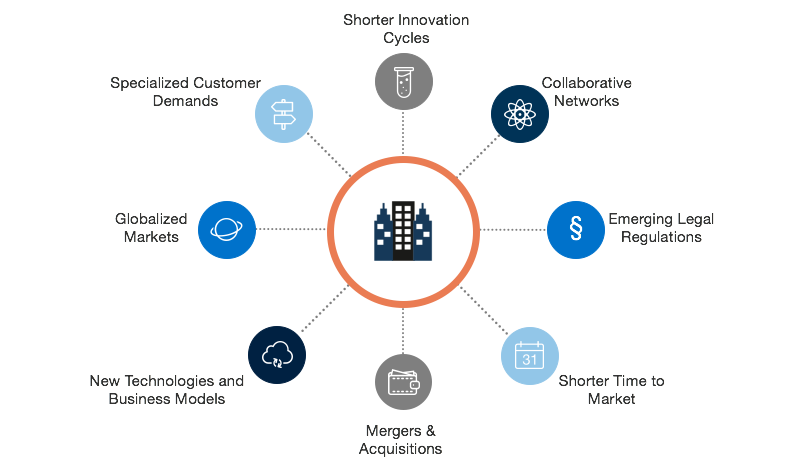Fast changing environments lead to the need for continuous business transformation. EAM is a good measure to cope with need [Mat+12].
Motivational Factors
In today’s world, enterprises are under continuous pressure to keep up with a fast changing environment [Mat+12]. An overview of possible influence factors is given in Figure 1.

Figure 1: Non-exhaustive list of EAM drivers.
Influence factors like globalized markets [Myk+11; Mat+12; Buc10b; Han12a], specialized customer demands [Myk+11; Ale+15] and emerging legal requirements [Myk+11; Buc10b; Man12; Han12a; Fuh11d; Ale+15; Mat+12] force the business to steadily adapt to new realities. Moreover, shorter innovation cycles [Han12a], new technologies and business models [BBL12; Buc10b; Man12; Ale+15], M&As [Man12; Fuh11d; Ale+15], a shorter time to market as well as collaborative networks create pressure on enterprise. A prominent means to support the resulting need for enterprise transformation is Enterprise Architecture Management [Myk+11; Ale+15].
Sources:
| [BBL12] |
S. Bente, U. Bombosch, and S. Langade. Collaborative Enterprise Architecture: Enriching EA with Lean, Agile, and Enterprise 2.0 Practices. Elsevier, Inc., 2012. |
|
[Man12] |
T. Mannmeusel. “Management von Unternehmensarchitekturen in der Praxis: Organisatorische Herausforderungen in mittelständischen Unternehmen.” In: Analyse und Gestaltung leistungsfähiger IS-Architekturen Modellbasierte Methoden aus Forschung und Lehre in der Praxis. Ed. by J. Suchan C; Frank. Berlin Heidelberg: Springer Verlag, 2012, pp. 35–57. |
|
[Han12a] |
I. Hanschke. “EAM - einfach und effektiv.” In: Wirtschaftsinformatik & Management (WuM), Springer Verlag 04.2012 (2012), pp. 72–76. |
|
[Fuh11d] |
K. Fuhrer. “Teil 4: Standardblickwinkel und Praxissichten Infrastruktur und Technologie, Resümee und Ausblick.” In: Enterprise Architecture Deliverables: Welche Ergebnisse liefert Enterprise Architecture? OPITZ CONSULTING GmbH. 2011. |
|
[Myk+11] |
M. Mykhashchuk, S. Buckl, T. Dierl, and C. M. Schweda. “Charting the landscape of enterprise architecture management.” In: 10th International Conference on Wirtschaftsinformatik, 16th-18th February 2011, Zurich, Switzerland. 2011. |
|
[Ale+15] |
P. Aleatrati Khosroshahi, M. Hauder, A. W. Schneider, and F. Matthes. Enterprise Architecture Management Pattern Catalog V2. Tech. rep. Munich, Germany: Technichal University of Munich (TUM), 2015. |
|
[Buc10b] |
S. Buckl. “A Design Theory Nexus for Situational Enterprise Architecture Management.” In: Proceedings of the 14th International IEEE Enterprise Distributed Object Computing Conference. IEEE Computer Society. IEEE Computer Society. Vitoria, Brazil, 2010, pp. 3–8. |
|
[Mat+12] |
F. Matthes, I. Monahov, A. Schneider, and C. Schulz. EAM KPI Catalog v 1.0. Tech. rep. Munich: Chair for Software Engineering of Business Information Systems. Technische Universität München., 2012. |